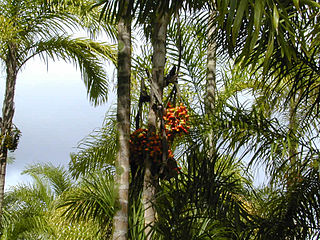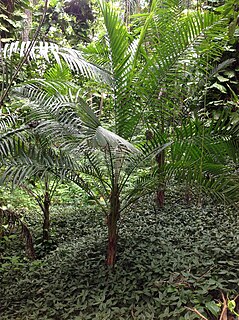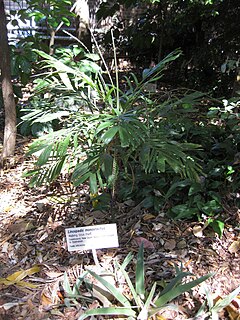
Areca is a genus of about 50 species of palms in the family Arecaceae, found in humid tropical forests from the islands of the Philippines, Malaysia and India, across Southeast Asia to Melanesia. The generic name Areca is derived from a name used locally on the Malabar Coast of India.

Bactris is a genus of spiny palms which is native to the Mexico, South and Central America and the Caribbean. Most species are small trees about 2 m tall, but some are large trees while others are shrubs with subterranean stems. They have simple or pinnately compound leaves and yellow, orange, red or purple-black fruit. The genus is most closely related to several other spiny palms—Acrocomia, Aiphanes, Astrocaryum and Desmoncus. The fruit of several species is edible, most notably B. gasipaes, while others are used medicinally or for construction.

Aiphanes is a genus of spiny palms which is native to tropical regions of South and Central America and the Caribbean. There are about 26 species in the genus, ranging in size from understorey shrubs with subterranean stems to subcanopy trees as tall as 20 metres (66 ft). Most have pinnately compound leaves ; one species has entire leaves. Stems, leaves and sometimes even the fruit are covered with spines. Plants flower repeatedly over the course of their lifespan and have separate male and female flowers, although these are borne together on the same inflorescence. Although records of pollinators are limited, most species appear to be pollinated by insects. The fruit are eaten by several birds and mammals, including at least two species of amazon parrots.

Acca is a genus of shrubs and small trees in the family Myrtaceae that is native to South America. Acca was first described as a genus in 1856. The genus comprises exactly three species. Acca sellowiana is cultivated for its edible fruits, known as feijoas or pineapple guavas.
- Acca lanuginosa(Ruiz & Pav. ex G.Don) McVaugh - central + southern Peru
- Acca macrostema(Ruiz & Pav. ex G.Don) McVaugh - Bolivia, central + southern Peru
- Acca sellowiana(O.Berg) Burret - southeastern + southern Brazil, Uruguay, Misiones Province in Argentina

Reinhardtia is a genus in the palm family native to the northern Neotropics. It is a primarily Central American genus with five species distributed between southern Mexico and the extreme north of Colombia, and one isolated species, Reinhardtia paiewonskiana in the southwest of the Dominican Republic.

Desmoncus is a genus of mostly climbing, spiny palms native to the Neotropics. The genus extends from Mexico in the north to Brazil and Bolivia in the south, with two species present in the southeastern Caribbean.
Karl Ewald Maximilian Burret, commonly known as Max Burret was a German botanist.

Balaka seemannii is a species of flowering plant in the family Arecaceae that is endemic to Fiji; growing in mixed forests on Vanua Levu and Taveuni islands.
Cyphosperma is a genus of flowering plant in the family Arecaceae, native to various islands of the Pacific. It contains the following species:

Linospadix is a genus of flowering plant in the family Arecaceae. It is native to New Guinea and Australia.

Pinanga is a genus of flowering plant of the palm family in the subtribe Arecinae. It is native to eastern and southern Asia across to New Guinea.

Plectocomia is a genus of flowering plant in the family Arecaceae native to China, the Himalayas, and Southeast Asia. It contains the following known species:

Ptychosperma is a genus of flowering plant in the family Arecaceae. Most are native to Australia and/or New Guinea, with a few in the Solomon Islands and in Maluku Province of eastern Indonesia. Some have been cultivated abroad as house or garden plants, and reportedly naturalized in certain regions.

Balaka is a genus of 9 known species in the palm family, Arecaceae or Palmae. Seven species are native to the islands of Fiji and two to Samoa. The genus was first proposed and published in Annales du Jardin Botanique de Buitenzorg 2: 91. 1885, from two species originally in the genus Ptychosperma.

Euterpe precatoria is a tall, slender-stemmed, pinnate-leaved palm native to Central and South America and Trinidad and Tobago. E. precatoria is used commercially to produce fruits, although Euterpe oleracea is more commonly cultivated due to its larger fruits.

The Gibraltar Botanic Gardens or La Alameda Gardens are a botanical garden in Gibraltar, spanning around 6 hectares. The Rock Hotel lies above the park.

Pholidostachys is a genus of palms found in Central America and northwestern South America.
Kjellbergiodendron is a genus of the botanical family Myrtaceae, first described as a genus in 1936. It contains only one known species, Kjellbergiodendron celebicum, endemic to the Island of Sulawesi in Indonesia.
Walter Carl Otto Busse was a German botanist, whose primary scholarly focus was on German agriculture and the plants, fungi and lichen of Africa.














